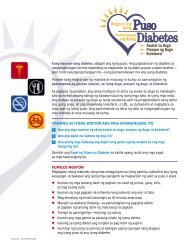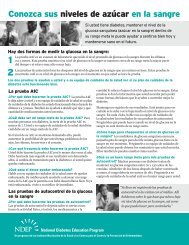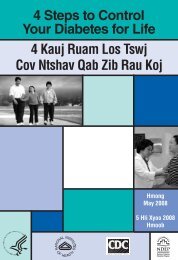Power to Prevent - National Diabetes Education Program - National ...
Power to Prevent - National Diabetes Education Program - National ...
Power to Prevent - National Diabetes Education Program - National ...
Create successful ePaper yourself
Turn your PDF publications into a flip-book with our unique Google optimized e-Paper software.
in the Forward/Introduction section <strong>to</strong> help you. You need <strong>to</strong> order materials at least 6 weeks before<br />
the frst session <strong>to</strong> make sure that they arrive in time. All of the NDEP materials are included on the<br />
accompanying CD-ROM for your convenience.<br />
A Word About Evaluation<br />
Once you have begun conducting the program, you will want <strong>to</strong> know what effect it is having. You<br />
will no doubt want answers <strong>to</strong> the following questions: How can I tell if my program is working?<br />
How can participants tell if they are making progress? How can my sponsoring organization show<br />
that its activities are effective? In a word: evaluation.<br />
Don’t let the word “evaluation” scare you. Your evaluation process does not need <strong>to</strong> be rigid;<br />
progress can be defned and measured in many ways. Evaluation can help you assess general<br />
reactions <strong>to</strong> your program so that you can modify the format or activities <strong>to</strong> meet participants’<br />
needs. The NDEP developed evaluation <strong>to</strong>ols specifcally for <strong>Power</strong> <strong>to</strong> <strong>Prevent</strong> when the curriculum<br />
was pilot-tested. A set of evaluation questionnaires, revised after pilot-testing, is provided as part<br />
of the curriculum. Each questionnaire is designed <strong>to</strong> test knowledge, attitudes, and confdence<br />
about behavior change around the specifc <strong>to</strong>pics covered in a particular session. You can use the<br />
participants’ responses on the questionnaires for one session <strong>to</strong> help you plan the next session. For<br />
example, if the evaluation questionnaires show little progress in knowledge and confdence, you<br />
may want <strong>to</strong> have participants review particular concepts or practice certain skills. Pho<strong>to</strong>copying<br />
the evaluations and returning them <strong>to</strong> the participants will help them view their progress. They<br />
will see how far they have come in expanding their knowledge and in changing their attitudes and<br />
behaviors.<br />
If your <strong>Power</strong> <strong>to</strong> <strong>Prevent</strong> sessions are sponsored by an organization, reporting the answers collected<br />
by these evaluation <strong>to</strong>ols may help demonstrate the value of these sessions or may uncover some<br />
valuable “lessons learned.” This feedback may help you and the sponsoring organization improve<br />
the program. The evaluation data may also be useful in requesting fnancial support or donations of<br />
materials for future programs.<br />
Contents of this Guide<br />
This program leaders’ guide is provided <strong>to</strong> help you feel more comfortable with starting and<br />
conducting a <strong>Power</strong> <strong>to</strong> <strong>Prevent</strong> program for individuals and families in your community and <strong>to</strong><br />
“walk you through” each step. Six general <strong>to</strong>pics are covered:<br />
Sessions Snapshot<br />
The Sessions Snapshot section of this guide explains the concept “Small Steps. Big Rewards,”<br />
which is the central theme of the <strong>Power</strong> <strong>to</strong> <strong>Prevent</strong> program. It lists the sessions and includes general<br />
information about them.<br />
<strong>Program</strong> Preparation<br />
The <strong>Program</strong> Preparation section gives suggestions for identifying the target audience for your<br />
program and for locating potential community partners who can support your efforts. It also<br />
lists resources for how <strong>to</strong> use the media <strong>to</strong> promote your program.<br />
NDEP <strong>Power</strong> <strong>to</strong> <strong>Prevent</strong> <strong>Program</strong> Leaders Guide 2













